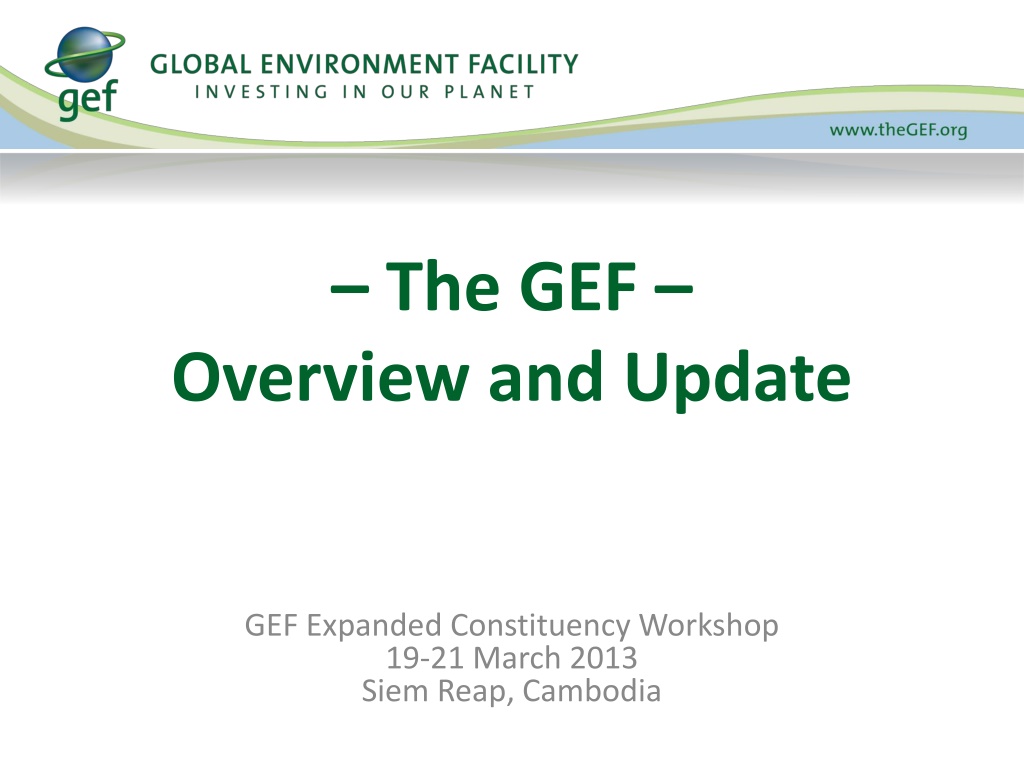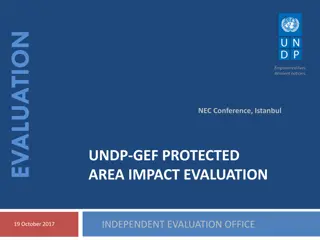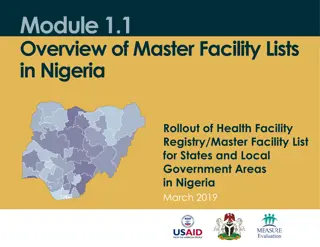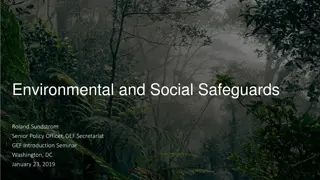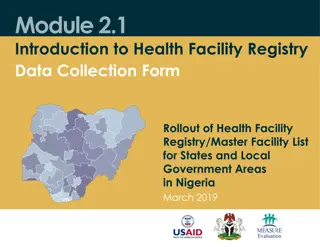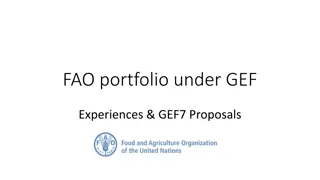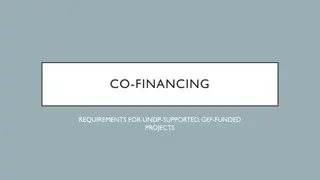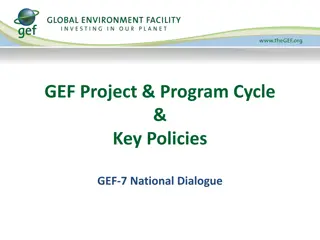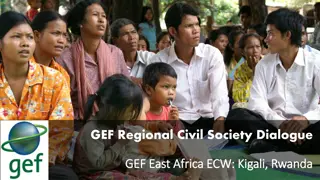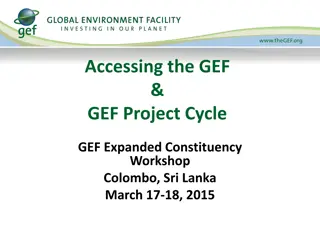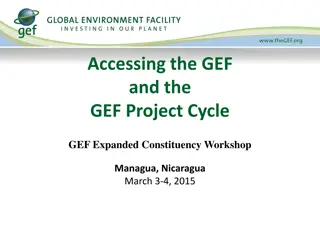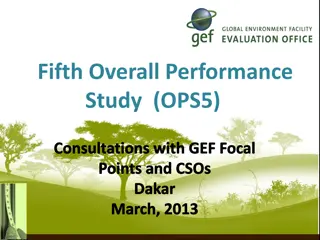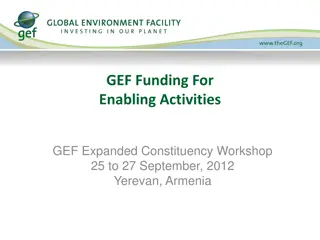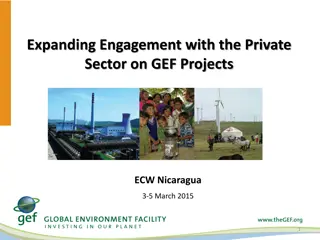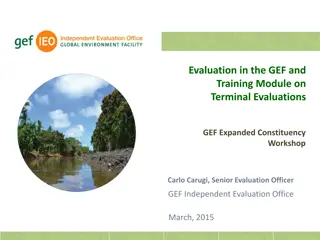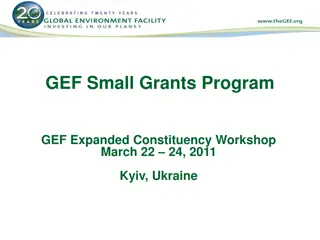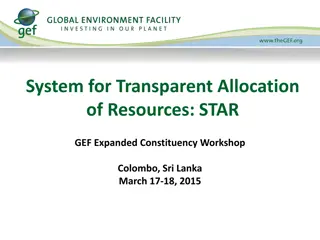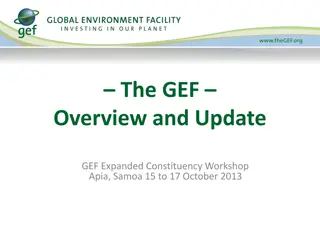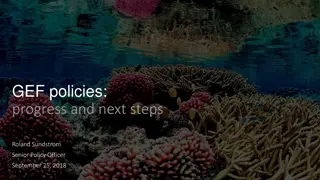Overview of the Global Environment Facility (GEF)
The Global Environment Facility (GEF) plays a crucial role as a financial mechanism for various environmental conventions. It has a rich history since its establishment in 1992 and has evolved to become the world's largest public funder of global environmental projects. The GEF Trust Fund operates with a structured framework involving various institutions, agencies, and stakeholders. Responsibilities of GEF agencies include overseeing project implementation, ensuring quality, and managing funds efficiently. The System for Transparent Allocation of Resources (STAR) allocates funds for biodiversity, climate change, and land degradation projects, with specific minimum allocations for each area.
Download Presentation

Please find below an Image/Link to download the presentation.
The content on the website is provided AS IS for your information and personal use only. It may not be sold, licensed, or shared on other websites without obtaining consent from the author.If you encounter any issues during the download, it is possible that the publisher has removed the file from their server.
You are allowed to download the files provided on this website for personal or commercial use, subject to the condition that they are used lawfully. All files are the property of their respective owners.
The content on the website is provided AS IS for your information and personal use only. It may not be sold, licensed, or shared on other websites without obtaining consent from the author.
E N D
Presentation Transcript
The GEF Overview and Update GEF Expanded Constituency Workshop 19-21 March 2013 Siem Reap, Cambodia
History of the GEF 1992 2013 1991 1994 $1 billion pilot program in the WB GEF serves as financial mechanism for: CBD UNFCCC Stockholm Conv. on POPs UNCCD Mercury (NEW) At the Rio Earth Summit, negotiations started to restructure the GEF out of the WB World s largest public funder of projects and programs to benefit the global environment Instrument for the Establishment of the Restructured GEF Also, although not linked formally to the Montreal Protocol, the GEF supports its implementation in transition economies. Initial partners: WB, UNDP, UNEP
GEF Trust Fund Institutional Framework Guidance Operations Action GEF Trustee STAP GEF Assembly Projects Countries: GEF OFPs / PFPs Convention FPs Other Gov t Agencies NGOs / CSOs Private Sector GEF Council Countries: Council Members / Constituencies GEF GEF Agencies UNDP UNEP WB ADB AfDB EBRD FAO IaDB IFAD UNIDO Secretariat Conventions CBD UNFCCC Stockholm (POPs) UNCCD Montreal Protocol Mercury Evaluation Office
Responsibility of GEF Agencies (1 of 2) Implementing Agency Project Oversight Ensure quality of preparation Disburse funds to Executing Agency Supervise implementation Be accountable to GEF Council Keep GEF OFP informed Help secure committed co-financing
Responsibility of GEF Agencies (2 of 2) Executing Agency Project Management Deliver project outcomes Day-to-day management of funds Report on results and use of funds
System for Transparent Allocation of Resources (STAR) (1 of 2) Biodiversity, Climate Change, and Land Degradation All countries have individual allocations Minimum allocations: $2M in CC $1.5M in BD $0.5M in LD Flexibility for smaller overall allocations ($7 M)
System for Transparent Allocation of Resources (STAR) (2 of 2) Programs without Allocations: International Waters POPs & Sound Chemicals Management Sustainable Forest Management Enabling Activities Cross-cutting capacity development Country Support Programme Regional & Global Projects & Programs Small Grants Programme Private Sector Engagement
PIFs cleared by CEO awaiting approval (M US$) GEF-5 Allocation Utilized (M US$) GEF-5 Replenishment US$4.25Bn STAR Allocations STAR Envelopes (M US$) CC BD LD Total Total Total Flexible Country 9.925 No Bangladesh 9.65 1.88 1.12 12.65 .79 3.7 Yes Bhutan 2.00 1.96 0.53 4.50 5.55 No Cambodia 2.21 3.85 1.22 7.28 154.75 No China 149.60 52.67 9.42 211.69 90.15 No India 93.75 30.58 5.10 129.43 2.4 5.58 No Lao PDR 3.26 6.11 1.49 10.86 18.33 No Malaysia 14.24 14.66 1.41 30.31 7.5 No .2 Mongolia 3.19 4.33 3.34 10.86 0 No Myanmar 7.12 6.72 1.51 15.35 .95 2.4 No Sri Lanka 2.67 7.84 2.16 12.68 8.861 No Thailand 20.10 9.05 2.48 31.63 15.95 No Vietnam 13.89 12.12 1.50 27.52
GEF-5 Project Cycle (1 of 4) PIF submitted on a rolling basis 18 months preparation for FSP: Council approval/ CEO Endorsement 12 months preparation for MSP: only if PPG requested PIF approval/project document approval
GEF Project Cycle (2 of 4) For FSPs Council approval of Work Program - PIFs cleared by the CEO Project implementation continues to completion - terminal evaluation and financial closure CEO endorsement of project GEF Agency approval of project Implementation starts
GEF Project Cycle (3 of 4) Specific Project Cycle Steps MSPs and EAs: Approved by the CEO on a rolling basis Programmatic Approaches: Currently under review
GEF Project Cycle (4 of 4) Streamlining Measures 1. PPG included in PIF template 2. MSP ceiling - $2 million 3. All templates simplified 4. Milestones monitored by GEFSEC 5. Agency fees: 40% at Council approval 60% at CEO endorsement 6. Umbrella projects for EAs approved by Council No separate endorsement for individual projects.
Harmonization Oct 2012: WB Harmonization Pilot discussion starts with the WB Objective To reduce administrative burden through involvement of GEF s Program Managers in project design. What has been harmonized 1)No Parallel Process for Decision Making 2)No GEF Review Sheets 3)No GEF-specific Project Templates 4)New business standard: from a 10 to a 5-day response
Other Funds LDCF, SCCF, NPIF, AF Additional Trust Funds Managed by the GEF Nagoya Protocol Implementation Fund (NPIF) Special Climate Change Fund (SCCF) Least Developed Countries Fund (LDCF) Secretariat Services Provided by the GEF Adaptation Fund (AF)
LDCF & SCCF LDCF SCCF Available to all developing countries, parties to UNFCCC Established to support Adaptation and Technology Transfer activities, short and long-term 41 adaptation projects approved, 6 for technology transfer SCCF resources now amount to USD 242 M. Established to address the special needs of LDCs under UNFCCC Only existing Fund mandated to finance the preparation and implementation of NAPAs 49 NAPAs funded already and 84 LDCF projects approved LDCF resources now amount to USD 540 M.
NPIF A separate trust fund created and managed by the GEF Established in Feb 2011 Funds are additional to STAR allocations Funds projects that: Provide actual Access and Benefit Sharing (ABS) Promote technology transfer & private sector engagement Review capacities and needs on ABS with focus on existing policies, laws and regulations
Adaptation Fund (1 of 3) A separate trust fund Managed by the Adaptation Fund Board (AFB) GEF provides secretariat services World Bank as trustee Established in 2007 Under Kyoto Protocol Resources 2% from monetized CERs Annex-I parties contributions Current Funding Availability: US$ 123.7M
Adaptation Fund (2 of 3) Governance AF Board - The AF Board is composed of 16 members and 16 alternates - A majority of members represent developing countries - AFB meets 3x a year, generally in Bonn - 2 representatives from each of the 5 UN regional groups - 1 representative of the SIDS - 1 representative of the LDCs - 2 other representatives from Annex I - 2 other representatives from non-Annex I
Adaptation Fund (3 of 3) Access Modalities National Implementing Entities (NIE) Direct Access Regional & Sub-Regional Entities (RIE) Multilateral Implementing Entity (MIE) Multilateral Implementing Entities The 50 % cap reached at the 19th Board meeting Pipeline established National / Regional Implementing Entities AF offers Project Formulation Grants
Green Climate Fund (GCF) (1 of 2) UNFCCC: An operating entity of the financial mechanism Mission: to support projects with a balanced allocation between CCA and CCM World Bank as Trustee Head Office: Incheon, South Korea
Green Climate Fund (GCF) (2 of 2) Governance GCF Board The GCF Board has 24 members and 24 alternates Composed of an equal number of developing and developed countries Including representatives of relevant UN regional groupings and representatives from SIDS and LDCs With necessary experience and skills, given gender balance Selected by their respective constituency or UN regional group 3-years term, eligible to additional terms 2 co-chairs (one from a developed, another from a developing country) Two-thirds of Board members needed for a quorum Decisions by consensus
Broadening the GEF Partnership GEF Council May 2011: Approval of a pilot to accredit up to 10 new institutions to serve as GEF Project Agencies At least 5 national institutions with size and regional balance Eligibility: national institutions, regional organizations, CSOs/NGOs, UN specialized agencies and programs, other int l organizations
Public Private Partnerships in GEF-5 (1 of 3) GEF-5 Private Sector Strategy: 3 Modalities 1. Establish Public-Private Partnership (PPP) Programs with multilateral development banks (MDBs) to support investments using non-grant instruments 2. Encourage countries to use STAR allocation grants for projects with private sector investments using non-grant instruments $ 30 M available now (very positive) 3. Support SME competitions to facilitate technology transfer and entrepreneurship
Public Private Partnerships in GEF-5 (2 of 3) Non-Grant Instrument Under the GEF instrument, a form of concessional finance that has the potential to earn a return (or reflow) Reflows are available to expand the pool of GEF resources available for future investments. Examples: Contingent Grant Credit Guarantee or Risk Guarantee Fund Equity Fund Investments Concessional Loans Performance Risk Guarantee Revolving Fund Risk Sharing Fund for Loan Provision
Public Private Partnerships in GEF-5 (3 of 3) PPPs Current Status The GEF June Work Program included two new PPPs $20 Million with AfDB for renewable energy loans $15 Million with IDB for equity investments in clean energy and bio-diversity UNIDO is coordinating to identify countries that wish to pursue SME competitions as MSPs
New GEF Fee Policy Start Date The Council requested the Secretariat to begin implementation of the new structure beginning 01 Jan 2013. Percentages All projects approved/cleared by CEO will be subject to the new fee policy as follows: 9.5% for GEF project grants up to and including $10 million 9.0% for GEF project grants above $10 million
GEF-6 Replenishment (1 of 3) Replenishment: process in which donor countries, every 4 years, voluntarily pledge to provide resources to fund the GEF operations. Previous Replenishments
GEF-6 Replenishment (2 of 3) Composition GEF Trustee (Chair) GEF CEO (Co-Chair) Donors: Minimum contribution SDR 4 M Recipients: 4 representatives (representing AFR, Asia/Pacific, ECA, and LAC) CSOs/NGOs: 2 representatives Observers: A) Potential donors B) GEF Agencies C) Conventions
GEF-6 Replenishment (3 of 3) Process: Timetable April 2013 (Paris) Sept. 2013 (TBD) Nov. 2013 (Washington) Feb. 2014 (TBD) Core Documents Documents Strategic Positioning Programming Policy GEF2020 Strategy OPS5 (GEFEO)
CEO Vision Statement Time for Transformational Change The role of the GEF The GEF is uniquely positioned to support the stewardship of the global environmental commons The GEF must be: a champion of the global commons, an innovator, the partner of choice for environmental benefits, a catalyst in the evolving architecture of environmental finance Principles in Action: Collective leadership and effective communication, Promoting country ownership, Resolute focus on achieving results, a lean and efficient organization
GEF 2020 A long-term strategy for the GEF Context Key Questions for the GEF The global environment is in crisis Transformational change is needed 1) What is the GEF operating context today and what are the trends that should drive its focus? 2) What are the areas/activities that the GEF is in the best position to support? 3) How can the GEF maximize its potential as catalyst for sustainable change at scale? 4) Which actions can the GEF take in the short, medium and long-term to implement the vision?
GEF Online Resources Website www.TheGEF.org Council Member List Focal Point List Country Profiles Country Fact Sheets Country Support Programme Documents & Publications Council Documents Work Programs Program Management Bulletin Publications/Videos Templates PIF, EAs PMIS Username and Password Pre-PIF Tracking Tool Project Information: Where to find PIFs, PFD, PIRs Social Media facebook.com/thegef1 twitter.com/thegef youtube.com/gefsecretariat
Thank you for your attention! Questions? The Global Environment Facility 1818 H Street, NW, Mail Stop P4-400 - Washington, DC 20433 USA Tel: (202) 473-0508 Fax: (202) 522-3240/3245 www.thegef.org / secretariat@thegef.org
